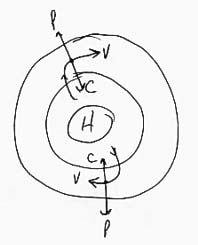
OCG123, Spring 2002
Answers to Second hourly exam, Friday 8 March
Chapters 4–6
Definitions (3 points each; 30
points total)
1. Latent heat—Heat released or absorbed during a change of phase.
Latent heat does not appear as temperature.
2. Coriolis effect—The apparent
rightward force on moving air or water in the Northern Hemisphere. The Coriolis
effect is independent of the direction of motion.
3. Convergence—A coming together of
air or water to a region in the atmosphere or ocean.
4. Thermohaline conveyor belt—The 3-D
oceanic circulation that is driven by differences in density that originate in
differences in T or S.
5. Halocline—A zone in the ocean
where salinity changes rapidly with height and creates corresponding differences
in density.
6. Gyre—A large-scale circular
circulation pattern in the ocean.
7. Asthenosphere—The zone of the
upper mantle that sits just below the lithosphere and is particularly ductile.
8. Low-velocity zone—The vertical
region of slower seismic waves at the top of the asthenosphere and is caused by
a small amount of molten rock.
9. S wave—A secondary (shear) seismic
wave that travels perpendicular to the perturbation. S waves exist only in
solids.
10. Mantle—The solid layer of the
earth between the crust and the core.
Short answers (5 points each; 40
points total)
1. Why are there so many deserts around latitudes 30º N and 30º S? Use
a diagram if you wish. The deserts around latitudes 30º N and 30º S are
created by the descending air at the border of the equatorial and midlatitude
cells of the three-celled circulation. They also correspond to areas of
semipermanent high pressure.
2. Explain how the oceans and atmosphere work together to redistribute
the excessive solar heating at the equator. The main oceanic gyres transfer
the excess heat from the equator to latitudes of 30º–40º N and S. The
atmosphere takes over there, and takes the heat to the poles.
3. What creates the earth’s magnetic field? “Vertical”
convection cells in the molten outer core, which are transporting excess heat
the first step of the way toward the surface.
4. Explain the differences in driving forces for surface circulation and
deep circulation in the oceans. The surface circulation is driven by wind,
the deep circulation by differences in density, particularly the high densities
of cold, saline polar water.
5. What creates bottom water? Name the two major places where it is
formed. Bottom water is formed at the surface near the poles, in regions
where the polar ice pack is forming and excluding seasalt from its matrix. The
main regions are Greenland/Iceland and the Weddell Sea.
6. What is the difference between convergent and divergent plate
boundaries? Give an example of each. Convergent boundaries are places where
two plates are colliding, divergent boundaries where they are separating. The
Marianas Trench (Pacific and Philippine plates) is an example of the first, the
Mid-Atlantic Ridge the second.
7. From where did the earth get enough heat to form a core of molten
iron? From a combination of potential energy released during accretion,
kinetic energy of bombarding objects, radioactivity, and potential energy
released as the dense iron and nickel sank to form the core. The first two were
probably the main sources.
8. Use the vector balance of forces to show why air flows clockwise
around a high-pressure area in the Northern Hemisphere.

When the motion reaches a clockwise path parallel to the isobars, the pressure force P and the Coriolis force C cancel one another and produce zero net force, or zero net acceleration (geostrophic motion). The same analysis applied to a low-pressure cell produces counterclockwise motion (also geostrophic).
Problems and longer answers (10
points each; 30 points total)
1. Use diagrams to derive the earth’s three-celled atmospheric
circulation. Be sure to show why one cell and two cells don’t work.
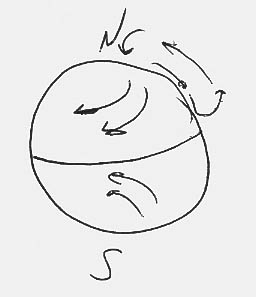
One-celled motion doesn't work because it produces westward motion over the entire globe. This would frictionally slow down the earth's speed of rotation. But photons from the sun cannot do this, because half would tend to speed up the earth.
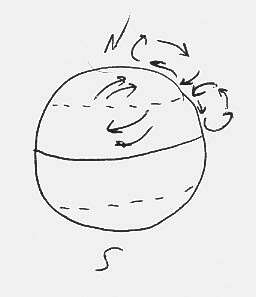
Two-celled motion can balance the frictional force, but create upward-moving air at the poles.
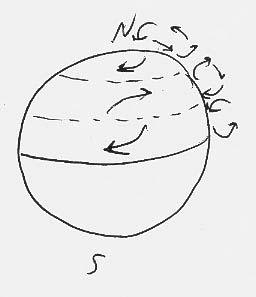
Three-celled motion can satisfy both the need for zero net friction and air rising and falling at the proper latitudes.
2. Use vectors to show how the first two or three layers of the Ekman spiral are formed in the ocean. Be sure to balance the three forces: the drag from above, the Coriolis force, and friction with the layer below. Which direction is the “Ekman transport” (the vertically integrated flow)?
Surface layer of water

C + F balances W to give no net acceleration and therefore steady motion. Note how the motion of the water has been deflected rightward form the motion of the wind.
Layer just beneath the surface

C + F again balances the Drag, which this time comes from the layer of water above. This subsurface layer is again deflected to the right of its driving force.
3. It is said that drifting continents and plate tectonics are the surface expressions of heat escaping from the core of the earth. Describe the chain of influences inside the earth that lead to plate tectonics (drifting continents). Start from the core, progress up through the mantle, and into the asthenosphere and lithosphere. Use a diagram if it will help.
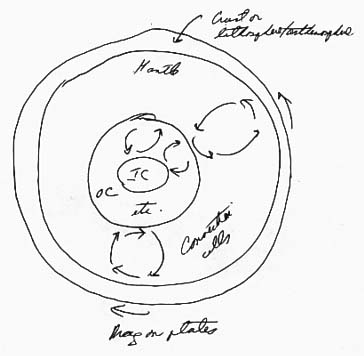
The heat escaping from the solid inner core (IC) sets up "vertical" convection cells in the liquid outer core (OC). That carries heat to the bottom of the mantle, where it in turn sets up convection cells throughout the mantle, either in one thick layer or two smaller ones. The top of those cells moves horizontally along the bottom of the asthenosphere and drags the plates with it, creating drifting continents and plate tectonics. This plate tectonics is ultimately the surface expression of hear escaping from the core.